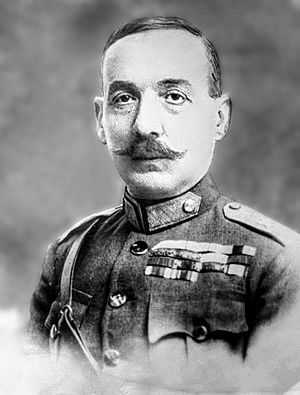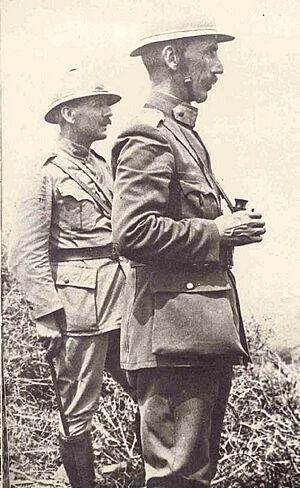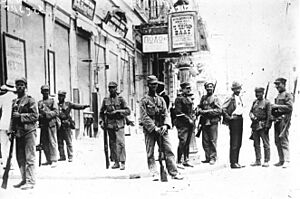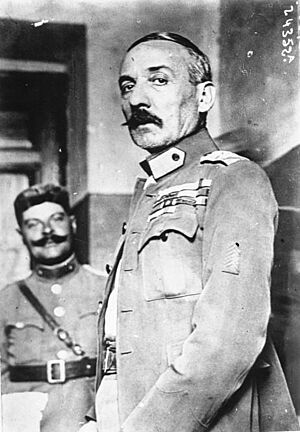Theodoros Pangalos (general) facts for kids
Quick facts for kids
Theodoros Pangalos
|
|
|---|---|
| Θεόδωρος Πάγκαλος | |

Theodoros Pangalos, c. early 1920s.
|
|
| President of Greece | |
| In office 19 July 1926 – 22 August 1926 |
|
| Prime Minister | Athanasios Eftaxias |
| Preceded by | Pavlos Kountouriotis |
| Succeeded by | Pavlos Kountouriotis |
| Prime Minister of Greece | |
| In office 25 June 1925 – 19 July 1926 |
|
| Preceded by | Andreas Michalakopoulos |
| Succeeded by | Athanasios Eftaxias |
| Personal details | |
| Born | January 11, 1878 Salamis, Kingdom of Greece |
| Died | February 26, 1952 (aged 74) Athens, Kingdom of Greece |
| Political party | Independent (Venizelist) |
| Spouse |
Arianna Slias-Sachtouris
(m. 1901) |
| Relations | Theodoros Pangalos (grandson) |
| Children | Theseus Dimitris Georgios Amalia |
| Alma mater | Hellenic Military Academy |
| Profession | Military officer |
| Awards | |
| Military service | |
| Allegiance |
|
| Branch/service | |
| Years of service | 1900–1926 |
| Rank | |
| Battles/wars | Balkan Wars
Greco-Turkish War (1919-1922)
|
Theodoros Pangalos (Greek: Θεόδωρος Πάγκαλος; born January 11, 1878 – died February 26, 1952) was an important Greek general and politician. He became a leader in Greece during a time of big changes. Pangalos was known for being a strong supporter of Eleftherios Venizelos and against the monarchy (kings and queens).
He played a key role in the revolt of September 1922. This event removed King Constantine I from power. It also helped create the Second Hellenic Republic, which was a republic instead of a kingdom. In June 1925, Pangalos took control of the government without fighting. The National Assembly then made him Prime Minister. He ruled Greece with strong powers until August 1926. From April 1926 until he was removed, he was also the President of the Republic.
After his time in power, Pangalos stepped away from public life for a while. However, he stayed involved with military groups who supported Venizelos. During World War II, when Germany occupied Greece, Pangalos was involved in setting up certain military groups. After the war, a court cleared him of any wrongdoing. He tried to get back into politics but was not successful. He passed away in 1952.
Contents
Early Life and Military Career
Theodoros Pangalos was born on January 11, 1878, on the island of Salamis. His family had a history of fighting for Greece's freedom. He studied at the Greek Army Academy and became an Infantry Second Lieutenant in 1900. He also continued his education in Paris, France.
During the Balkan Wars (1912–1913), he worked as a staff officer. He led the forces that entered Sidirokastro during the Second Balkan War. In 1916, he joined Eleftherios Venizelos's Provisional Government of National Defence. This government was against King Constantine I. Pangalos helped recruit soldiers for the new government. When King Constantine left power in 1917, Pangalos became a chief in the Ministry of Military Affairs. Later, he served at the Macedonian front during World War I. He was dismissed from the army in November 1920 after a new government came to power.
Role in the Greek Republic
In 1922, Pangalos supported the 11 September 1922 Revolution. This revolution was led by Nikolaos Plastiras. It ended the monarchy and created the Second Hellenic Republic. Pangalos was very important in quickly setting up the new government in Athens. He was named Minister for Military Affairs in November 1922. His job was to reorganize the Greek army in Macedonia and Thrace. This was important because the war with Turkey was not over.
Pangalos's work in reorganizing the "Army of Evros" was very successful. This strong army helped Greece in peace talks with Turkey. The Treaty of Lausanne was signed, ending the war. Pangalos, a strong nationalist, did not like the terms of the treaty. He even said his troops would attack Turkey to stop the deal. He had to resign, but his strong stance made him popular. In the years that followed, Pangalos held several government positions. He helped stop a coup attempt in October 1923. He was also elected to Parliament for Thessaloniki.
Pangalos Takes Power
On June 24, 1925, military officers who supported Pangalos took over the government. They were worried about the country's political instability. They forced President Pavlos Kountouriotis to make Pangalos the Prime Minister. Pangalos quickly took strong control. He stopped freedom of the press and passed strict laws. For example, there was a law about how long women's skirts could be.
On January 3, 1926, Pangalos declared a state of emergency. He took on even more dictatorial powers. In April 1926, he made sure he was elected president in an election. He also tried to improve the economy by cutting paper money in half.
However, his leadership soon faced problems. He gave too many trade rights to Yugoslavia in Thessaloniki. He also got Greece involved in a small conflict called the War of the Stray Dog. This hurt Greece's relationships with other countries. Many of the officers who had helped him come to power decided he needed to be removed. He also tried to form an alliance with Italy against Turkey, but this was not successful.
On August 29, 1926, General Georgios Kondylis led a counter-coup. Pangalos was removed from power, and Kountouriotis became president again. Pangalos was then imprisoned for two years.
Later Life and Legacy
In 1930, Pangalos was sent to prison for some financial issues related to building projects. He was released after two years. He never regained the popularity he had before his coup. He also never played a major role in Greek politics again.
When Germany occupied Greece during World War II, Pangalos supported the new Greek government that worked with the Germans. He was involved in setting up certain military groups during this time. After Greece was liberated, Pangalos was arrested. However, he was cleared of all charges in September 1945. He tried to run for parliament in 1950 but was not successful. He died in Kifissia two years later.
His grandson, also named Theodoros Pangalos, later became the Deputy Prime Minister of Greece. He was a member of the PASOK socialist party.
Images for kids
See also
 In Spanish: Theodoros Pangalos para niños
In Spanish: Theodoros Pangalos para niños





